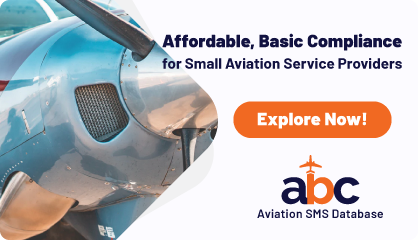
Pros and Cons of Sharing Hazard Risk Registers
In the high-stakes world of aviation, safety is paramount. For aviation safety managers and accountable executives, maintaining a robust hazard risk register and implementing effective risk controls are critical to ensuring operational safety and regulatory compliance. However, a growing debate centers on whether to share these risk registers and controls with industry peers, regulators, or the public. Sharing can promote safety and foster collaboration but may compromise competitive advantages and expose vulnerabilities.
This comprehensive guide explores the pros and cons of sharing hazard risk registers and risk controls, offering insights tailored to aviation safety professionals navigating this complex decision.
Why Sharing Hazard Risk Registers Matters in Aviation
A hazard risk register is a dynamic document that identifies potential hazards, assesses their likelihood and impact, and outlines mitigation strategies. Risk controls are the specific measures—procedural, technological, or training-based—designed to manage those risks. In aviation, these tools are vital for preventing incidents, ensuring compliance with regulations like those from the International Civil Aviation Organization (ICAO) or the Federal Aviation Administration (FAA), and protecting passengers, crew, and assets.
The decision to share these documents is not straightforward. Aviation safety managers and accountable executives must weigh the benefits of transparency—such as industry-wide safety improvements—against risks like loss of competitive edge or legal liabilities. Let’s dive into the pros and cons, with a focus on how this decision impacts aviation organizations.
Pros of Sharing Hazard Risk Registers and Risk Controls
1. Enhancing Industry-Wide Safety
Sharing hazard risk registers and risk controls can significantly elevate safety standards across the aviation industry. By disseminating lessons learned from near-misses, incidents, or innovative risk mitigation strategies, organizations contribute to a collective knowledge base that benefits all stakeholders. For example, sharing data on runway incursion risks or fatigue management controls can help other airlines or airports implement proven solutions, reducing the likelihood of accidents.
In aviation, initiatives like the Aviation Safety Information Analysis and Sharing (ASIAS) program demonstrate the power of collaborative safety data sharing. By pooling de-identified data, participants have reduced risks associated with controlled flight into terrain (CFIT) and other hazards. For safety managers, participating in such programs positions their organization as a leader in safety culture.
2. Building Trust with Regulators and the Public
Transparency fosters trust. Sharing risk registers, even in anonymized or aggregated form, signals to regulators, passengers, and stakeholders that an organization prioritizes safety over secrecy. This can enhance relationships with bodies like the FAA, EASA, or ICAO, potentially leading to more collaborative regulatory oversight rather than punitive measures.
For accountable executives, public trust is a strategic asset. In an era where passengers are increasingly safety-conscious, demonstrating a commitment to openness can differentiate an airline or operator in a competitive market. For instance, airlines that voluntarily share safety performance metrics often enjoy stronger brand loyalty.
3. Driving Collaborative Innovation
Aviation is a complex ecosystem involving airlines, airports, manufacturers, and air traffic control. Sharing risk data can spark collaborative innovation, leading to new technologies, procedures, or training programs. For example, sharing insights on bird strike risks could lead to joint development of advanced radar systems or wildlife management protocols.
Safety managers can leverage platforms like the Commercial Aviation Safety Team (CAST) to share and access data, fostering solutions that no single organization could develop alone. This collaborative approach not only enhances safety but also positions organizations as thought leaders in aviation safety.
4. Reducing Costs Through Shared Knowledge
Developing risk controls from scratch is resource-intensive, requiring expertise, testing, and validation. By sharing and accessing proven controls, organizations can avoid reinventing the wheel, saving time and money. For smaller operators or regional airports, this access to shared knowledge can be a game-changer, enabling them to implement high-quality controls without prohibitive costs.
Additionally, a strong safety record bolstered by shared best practices can lower insurance premiums and reduce liability risks. Accountable executives will appreciate the financial benefits of a proactive safety strategy that leverages industry collaboration.
5. Strengthening Reputation as a Safety Leader
In aviation, reputation is everything. Sharing hazard risk registers and controls can position an organization as a safety pioneer, attracting safety-conscious customers, top talent, and investors. For safety managers, this aligns with the goal of embedding a just culture where safety is a shared responsibility.
For example, airlines that participate in voluntary safety reporting programs like the Flight Operational Quality Assurance (FOQA) often gain recognition as industry leaders. This reputation can translate into market advantages, even in a competitive landscape.
Cons of Sharing Hazard Risk Registers and Risk Controls
1. Risking Competitive Advantage
Aviation is a fiercely competitive industry, and proprietary risk controls or unique safety processes can provide a significant edge. For instance, an airline’s advanced fatigue risk management system or a manufacturer’s proprietary maintenance protocol could differentiate it from competitors. Sharing these details risks leveling the playing field, allowing competitors to adopt similar strategies without the investment.
For accountable executives, protecting competitive advantages is a strategic priority. Sharing sensitive data could erode market differentiation, especially if competitors use the information to enhance their own operations without reciprocating.
2. Exposing Intellectual Property
Risk controls often involve proprietary technologies, processes, or training methodologies. Sharing these details could compromise intellectual property (IP), enabling competitors to replicate or adapt them. For example, a unique algorithm for predictive maintenance or a specialized pilot training simulator could lose its value if shared openly.
Safety managers must ensure that shared data is anonymized or generalized to protect IP. However, this process can be resource-intensive, requiring legal and technical expertise to safeguard proprietary information.
3. Potential for Misuse or Misinterpretation
Shared risk data can be misused or misinterpreted, leading to unintended consequences. Competitors might exploit vulnerabilities disclosed in a risk register to tarnish an organization’s reputation or gain a market advantage. For instance, highlighting a specific operational risk could be sensationalized by media or competitors, damaging public perception.
Additionally, risk controls are often context-specific. If another organization applies shared controls without understanding the nuances, it could lead to ineffective or even harmful outcomes. Safety managers must weigh the risk of misapplication when deciding what to share.
4. Legal and Liability Risks
Sharing hazard risk registers can expose organizations to legal and regulatory scrutiny. If disclosed risks are perceived as inadequately managed, it could invite lawsuits from passengers, employees, or stakeholders. For example, publicizing a risk related to aging aircraft could trigger class-action lawsuits or regulatory audits, even if controls are in place.
Accountable executives must consider the legal implications of transparency. While voluntary reporting programs often offer protections, public disclosures may not. Legal counsel is essential to navigate these risks and ensure compliance with data-sharing regulations.
5. Resource and Time Demands
Preparing risk registers and controls for sharing is a significant undertaking. Data must be sanitized to protect sensitive information, formatted for external use, and reviewed for legal and strategic implications. This process diverts resources from other safety priorities, such as incident investigations or training programs.
For smaller organizations with limited staff, the resource burden of sharing can be particularly challenging. Safety managers must balance the benefits of collaboration with the practical constraints of time and budget.
Key Considerations for Aviation Safety Managers and Executives
The decision to share hazard risk registers and risk controls is not binary. Aviation safety professionals can adopt a strategic approach to balance safety promotion with competitive and legal considerations. Here are key factors to guide the decision:
1. Data Sensitivity and Anonymization
To mitigate risks, organizations can share anonymized or aggregated data rather than detailed, company-specific information. For example, contributing de-identified data to industry programs like ASIAS allows safety benefits without exposing proprietary details. Safety managers should work with data analysts to ensure shared information is generalized while remaining useful.
2. Industry Norms and Collaboration Platforms
Aviation has a strong tradition of safety collaboration, exemplified by programs like CAST, ASIAS, and the Global Aviation Safety Plan (GASP). Participating in these platforms allows organizations to share data within a trusted framework, minimizing competitive risks. Executives should evaluate which programs align with their strategic goals and safety priorities.
3. Stakeholder Expectations
Passengers, regulators, and employees increasingly expect transparency in aviation safety. However, shareholders may prioritize protecting competitive advantages. Safety managers and executives must engage stakeholders to align sharing decisions with organizational values and market positioning.
4. Selective Sharing Strategies
Not all data needs to be shared with everyone. Organizations can adopt a tiered approach, sharing high-level insights with the public, detailed data with trusted partners, and anonymized data with industry consortia. For example, sharing general lessons learned from a bird strike incident can promote safety without revealing proprietary radar technology.
5. Legal and Regulatory Compliance
Before sharing, organizations must ensure compliance with data protection laws (e.g., GDPR for European operations) and aviation regulations. Legal counsel can help navigate confidentiality agreements, intellectual property protections, and liability risks. Safety managers should also leverage protections offered by voluntary reporting programs to minimize legal exposure.
Best Practices for Sharing Hazard Risk Registers and Controls
To maximize the benefits of sharing while minimizing risks, aviation safety managers and accountable executives can follow these best practices:
- Develop a Sharing Policy: Create a clear policy outlining what data can be shared, with whom, and under what conditions. Include guidelines for anonymization and legal review.
- Leverage Industry Platforms: Participate in established programs like ASIAS, CAST, or IATA’s Safety Trend Evaluation, Analysis, and Data Exchange System (STEADES) to share data securely.
- Engage Stakeholders: Communicate the benefits of sharing to internal stakeholders (e.g., board members, employees) and external stakeholders (e.g., regulators, customers) to build support.
- Invest in Data Security: Use secure data-sharing platforms and encryption to protect sensitive information from unauthorized access.
- Monitor Outcomes: Track the impact of sharing on safety performance, reputation, and competitive positioning to refine strategies over time.
Conclusion: Striking the Right Balance
For aviation safety managers and accountable executives, sharing hazard risk registers and risk controls is a strategic decision that requires careful consideration of safety, competition, and collaboration. The benefits—enhanced industry safety, regulatory trust, collaborative innovation, cost savings, and reputational gains—are compelling. However, the risks—loss of competitive advantage, IP exposure, misuse of data, legal liabilities, and resource demands—cannot be ignored.
By adopting a strategic, selective approach to sharing, leveraging industry platforms, and prioritizing data security, aviation organizations can promote safety without compromising their market position. In an industry where trust and safety are non-negotiable, finding the right balance is not just a choice—it’s a responsibility.
Call to Action
Are you an aviation safety manager or accountable executive navigating the complexities of data sharing? Share your experiences or questions in the comments below. For more insights on aviation safety strategies, subscribe to our blog or contact our team for tailored guidance on building a collaborative safety culture. Need tools to easily manage hazards, risks, control measures, system description and interfaces? SMS Pro is known to have the best Proactive Hazard Analysis Tool that is envied by NASA and the FAA. Contact us for a live demo to see more.








